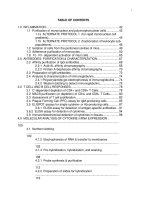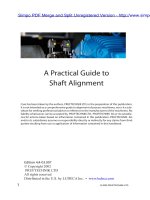A Practical Guide to Shaft Alignment phần 1 pdf
Bạn đang xem bản rút gọn của tài liệu. Xem và tải ngay bản đầy đủ của tài liệu tại đây (3.14 MB, 10 trang )
1
Edition 4;4-03.007
© Copyright 2002
PRUFTECHNIK LTD
All rights reserved
Distributed in the U.S. by LUDECA Inc. • www.ludeca.com
A Practical Guide to
Shaft Alignment
Care has been taken by the authors, PRUFTECHNIK LTD, in the preparation of this publication.
It is not intended as a comprehensive guide to alignment of process machinery, nor is it a sub-
stitute for seeking professional advice or reference to the manufacturers of the machinery. No
liability whatsoever can be accepted by PRUFTECHNIK LTD, PRUFTECHNIK AG or its subsidia-
ries for actions taken based on information contained in this publication. PRUFTECHNIK AG
and/or its subsidiaries assume no responsibility directly or indirectly for any claims from third
parties resulting from use or application of information contained in this handbook.
© 2002 PRUFTECHNIK LTD.
2
The purpose of producing this handbook is to provide basic information
and guidelines for the implementation of good shaft alignment for
standard rotating machine systems.
Laser alignment is an essential component of a viable maintenance
strategy for rotating machines. In isolation each strategy can help to
reduce unexpected machine failure but taken together they form the hub
of a proactive maintenance strategy that will not only identify incipient
problems but allows extending machine operating life considerably.
In each section of this handbook we have used one or two examples
of the available methods for measuring the required parameters. We
do not suggest that the methods illustrated are the only ones available.
Prueftechnik are specialists in the alignment and monitoring of rotating
machines, we have accumulated substantial practical knowledge of
these subjects over the 30 years of our existence, in so doing we have
produced many handbooks covering individual subjects and systems.
This handbook is a distillation of this accumulated knowledge plus a
brief overview in each section of the latest systems from Prueftechnik
that address the specic applications concerned.
We hope that this information is presented in a clear readable form
and that it will provide for the reader new to the subject a platform to
successfully apply protable maintenance practice in their plant.
We are indebted to our collegues in Prueftechnik AG (Germany) and our
associates at LUDECA Inc. (USA) for permission to reproduce some
of the graphics used in this handbook, additionally we have drawn on
information previously published in Prueftechnik equipment handbooks
for information on alignment standards, and graphical and mathematical
methods of balance calculation. For this information we are grateful.
Introduction
© 2002 PRUFTECHNIK LTD.
3
Shaft Alignment
Page
Number
What is shaft alignment 6
A denition 6
Machine catenary 7
Operation above critical speed 8
Expressing alignment 10
Alignment parameters 10
Angularity, gap and offset 11
Short exible couplings 14
Spacer shafts 15
How precise should alignment be? 18
Alignment tolerances 18
Troubleshooting 21
Coupling strain and shaft deection 21
Causes of machine breakdown 23
Couplings and misalignment 23
Bearings 24
Seal wear 24
Machine vibration 25
Symptons of misalignment 25
Alignment methods and practice 27
Machine installation guidelines 28
Measurement and correction of soft foot 29
Alignment by Eyesight 33
Introduction
© 2002 PRUFTECHNIK LTD.
4
Alignment by Dial indicator 36
Trial and error method 37
Rim and face method - by calculation 38
Reverse indicator method - by calculation 41
Indicator bracket sag measurement 43
Alignment by Laser 45
Basic operation requirements 48
Laser alignment case study
Laser alignment cuts energy costs 52
Laser alignment improves pump reliability 56
Laser alignment improves bearing & seal life 58
Laser alignment reduces vibration alarms 59
Thermal expansion of machines 60
Thermal growth calculations 61
Page
Number
Contents
© 2002 PRUFTECHNIK LTD.
5
Shaft
Alignment
© 2002 PRUFTECHNIK LTD.
6
What is shaft alignment?
A Denition
Shaft alignment is the process whereby two or more machines (typically
a motor and pump) are positioned such that at the point of power transfer
from one shaft to another, the axes of rotation of both shafts should be
colinear when the machine is running under normal conditions.
As with all standard denitions there are exceptions. Some coupling
types, for example gear couplings or cardan shafts, require a dened
misalignment to ensure correct lubrication when operating.
The important points to note in the above denition are.
At the point of power transfer
All shafts have some form of catenary due to their own weight, thus
shafts are not straight, therefore the location where the alignment of
the two shafts can be compared is only at the point of power transfer
from one shaft to the next.
the axes of rotation
Do not confuse “shaft alignment” with “coupling alignment”.
The coupling surfaces should not be used to dene alignment condition
since they do not represent the rotation axis of the shafts.
© 2002 PRUFTECHNIK LTD.
7
What is shaft alignment?
The accuracy of the t of the coupling on the shaft is unknown
Rotating only one shaft and using dial gauges to measure the opposing
coupling surface does not determine the axis of rotation of both shafts.
under normal operating conditions
The alignment condition can change when the machine is running. This
can be for a number of reasons including thermal growth, piping strain,
machine torque, foundation movement and bearing play. Since shaft
alignment is usually measured with the machines cold, the alignment
condition as measured is not necessarily the zero alignment condition
of the machines. (see page 60 - 62)
Alignment condition should be measured while turning the shafts in the
normal direction of rotation. Most pumps, fans and motors etc. have
arrows on the end casing showing direction of rotation.
Machinery catenary
The amount of shaft deection in a machine depends upon several
factors such as the stiffness of the shafts, the amount of weight between
overhanging supports, the bearing design and the distance between the
supports.
The natural deection of shafts under their own weight
© 2002 PRUFTECHNIK LTD.
8
What is shaft alignment?
For the vast majority of close coupled rotating machines this catenary
bow is negligible, and therefore for practical purposes can be ignored.
On long drive machine trains, e.g. turbine generators in power generation
plants or machines with long spacer shafts e.g. cooling tower fans or
gas turbines, the catenary curve must be taken into consideration.
In a steam turbine for example the shafts are usually aligned to each
other better than 4 mils, but the mid point of the center shaft could be
as much as 1.2 inches lower than the two end shafts.
Operation above critical speed?
When a very long, exible shaft begins to rotate, the bow of the shaft
tries to straighten out, but will never become a perfectly straight line. It
is important to understand that the axis of rotation of a shaft could very
possibly run on a curved axis of rotation. In situations where two or
more pieces of machinery are coupled together with one or more shafts
rotating around a catenary shaped axis of rotation, it is important to
align the shafts so that they maintain the curved centerline of rotation.
Drive shaft operation below critical speed:
Align machine couplings to spacer couplings
Machine catenary
© 2002 PRUFTECHNIK LTD.
9
What is shaft alignment?
Drive shaft operation above critical speed:
Align machine couplings to one another ignoring spacer.
© 2002 PRUFTECHNIK LTD.
10
Expressing alignment
Alignment parameters
Since shaft alignment needs to be measured and subsequently corrected,
a method of quantifying and describing alignment condition is
necessary.
Traditionally alignment has been described in terms of dial indicator
readings at the coupling face or position values at the machine feet. The
measured values from both of these methods are dependent upon the
dimensions of the machines. Since there are many different methods
for mounting dial indicators (reverse indicator, rim and face, double rim
for example) the comparison of measurements and the application of
tolerances can be problematic. Additionally the fact that rim indicator
readings show twice the true offset and sign reversals must be observed
depending on whether the indicator measures an internal or external,
left or right coupling face or rim.
A more modern and easily understandable approach is to describe
machine alignment condition in terms of angularity and offset in the
horizontal (plan view) and vertical (side view). Using this method four
values can then be used to express alignment condition as shown in the
following diagram.
© 2002 PRUFTECHNIK LTD.









